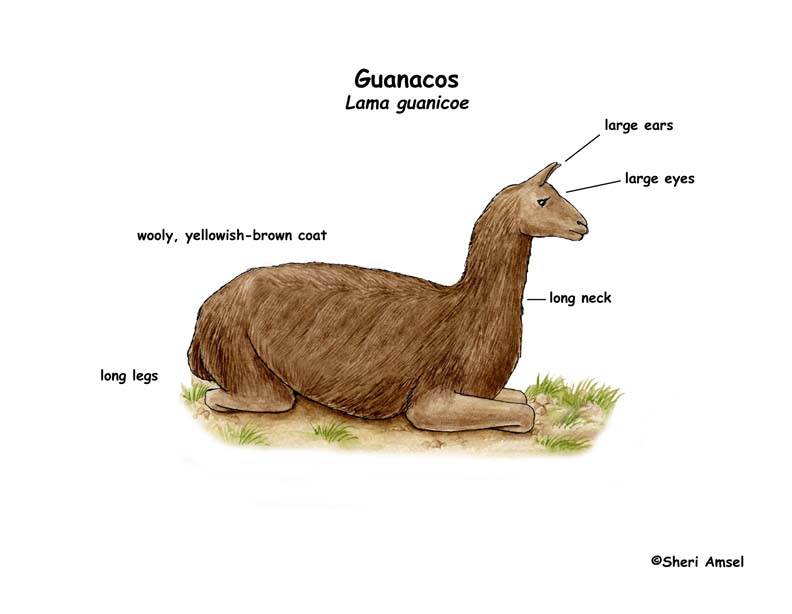

They once lived in the Andes Mountains throughout South America. Now they are only found in some mountainous areas of Peru, Chile, Argentina and Patagonia.
They live at above 12,000 feet in cold, dry, brushy areas.
They can weigh more than 200 pounds and stand up to 5 feet tall. They are covered with a tan to brown, warm, wooly fleece.
They live in groups of many females and their young with one male. Males with no females and very old males live alone. They are territorial, which means they protect one area and fend off other animals that try to come into it. When alarmed they have a loud cry to warn others in their group of a predator or danger. They can run 40 miles per hour.
They graze dry grasses and shrubs.
The young are hunted by fox or eagles. The adults are hunted by man.
Females are pregnant for a year (gestation). She has one baby that can eat grass and run away from predators in just a few days. The 15-25 pound newborn baby guanaco is very precocious and can graze and run about just a few days after birth. The mother may suckle her offspring up to six or eight months. The baby guanaco grows very fast: a female reaches sexual maturity at, perhaps, two, and adult size in three or four years.
They live about 20 years. They are listed as Lower Risk - least concern.
Kingdom: Animalia
Phylum: Chordata
Subphylum: Vertebrata
Class: Mammalia
Order: Artiodactyla
Family: Camelidae
Genus: Lama
Species: Lama guanicoe
When you research information you must cite the reference. Citing for websites is different from citing from books, magazines and periodicals. The style of citing shown here is from the MLA Style Citations (Modern Language Association).
When citing a WEBSITE the general format is as follows.
Author Last Name, First Name(s). "Title: Subtitle of Part of Web Page, if appropriate." Title: Subtitle: Section of Page if appropriate. Sponsoring/Publishing Agency, If Given. Additional significant descriptive information. Date of Electronic Publication or other Date, such as Last Updated. Day Month Year of access < URL >.
Amsel, Sheri. "Guanacos" Exploring Nature Educational Resource ©2005-2024. December 13, 2024
< http://www.exploringnature.org/db/view/Guanacos >

